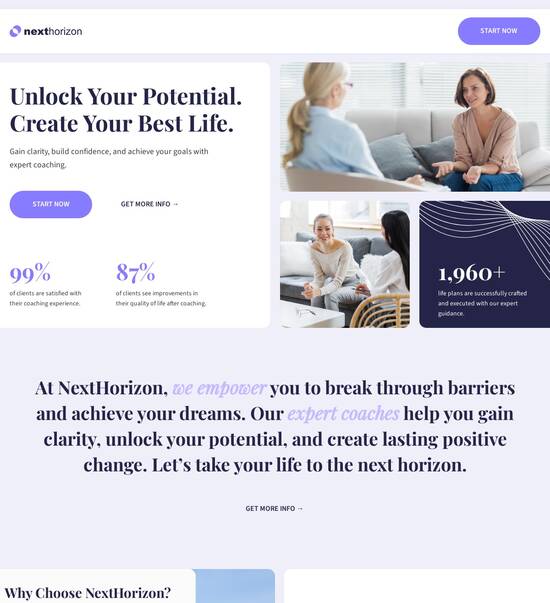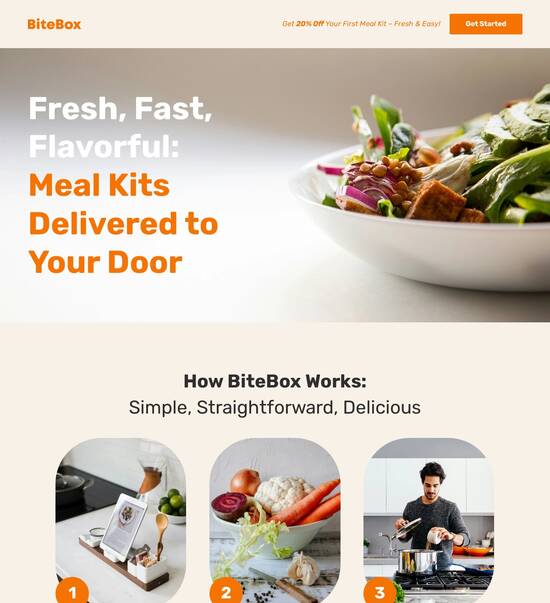
HTML page template with interactive travel feedback form
Explore Similar TemplatesAbout template
Use HTML page templates with interactive travel feedback form and make your communications easy and transparent. Try our solution today.
Recommended templates

Easy to build without coding
With the intuitive drag-and-drop builder, anyone on your team can create high-converting pages without any knowledge of code or design. Make enhancements to your landing page with custom widgets using Javascript, HTML/CSS, or third-party scripts.

Multiple layouts for any industry and goal
Select from 500+ landing page layouts built to boost conversions across industry-specific scenarios. Customize them by adjusting fonts, adding images, and generating on-brand content with the AI assistant. Quickly scale with Instablocks® and Global Blocks that you can save, reuse, and update globally.

Loads fast and looks polished on any device
Every template is responsive, which means they present professionally on any device and load blazingly fast with our Thor Render Engine. You can also power them up with Google AMP technology to deliver an unparalleled mobile experience and drive higher conversions.

Robust analytics & experimentation
Get real-time updates and reporting across all your devices, showing the number of visitors, conversions, cost-per-visitor, and cost-per-lead. Launch AI-powered experiments, run A/B tests, and use heatmaps to analyze user behavior, then optimize your landing page to maximize conversions.







Easy to build without coding
With the intuitive drag-and-drop builder, anyone on your team can create high-converting pages without any knowledge of code or design. Make enhancements to your landing page with custom widgets using Javascript, HTML/CSS, or third-party scripts.
Multiple layouts for any industry and goal
Select from 500+ landing page layouts built to boost conversions across industry-specific scenarios. Customize them by adjusting fonts, adding images, and generating on-brand content with the AI assistant. Quickly scale with Instablocks® and Global Blocks that you can save, reuse, and update globally.
Loads fast and looks polished on any device
Every template is responsive, which means they present professionally on any device and load blazingly fast with our Thor Render Engine.
Robust analytics & experimentation
Get real-time updates and reporting across all your devices, showing the number of visitors, conversions, cost-per-visitor, and cost-per-lead. Launch AI-powered experiments, run A/B tests, and use heatmaps to analyze user behavior, then optimize your landing page to maximize conversions.
All the features you need to build html feedback form
Explore more featuresLearn how to build travel feedback form template
Frequently asked questions about html review form
Leading the way in building high-performing landing pages





Free feedback form html: Your ultimate how-to guide
Instapage is the most powerful landing page and CRO platform, providing marketers with the tools to accelerate their campaigns and maximize ROI. This all-in-one platform excels in optimizing digital marketing strategies for various industries, including business services, education, and financial services. Let’s explore how you can effectively leverage Instapage for your marketing needs.
Understanding the importance of landing pages
Landing pages are crucial in converting visitors into leads or customers. A well-designed landing page reduces bounce rates and enhances user engagement. The integration of SEO-optimized content, persuasive calls-to-action, and targeted messaging can significantly improve your conversion rates.
- Captivating designs: Use Instapage's 100+ high-converting templates tailored for different industries.
- Lead generation: Implement pre-built lead generation elements to collect user information seamlessly.
- User-friendly interface: With no coding skills required, anyone can create effective landing pages quickly.
Step 1: How to create a landing page with Instapage
Creating a landing page doesn’t have to be complicated. With Instapage, you can follow these simple steps:
- Choose a template: Start by selecting from a wide array of customizable templates that suit your marketing goals.
- Utilize Instablocks: Drag and drop elements onto your page using Instablocks to create personalized layouts tailored to your audience.
- Publish and share: Once your page is ready, publish it live using Instapage's secure hosting or integrate it with your existing website.
Step 2: Optimizing for higher conversions
The optimization features of Instapage allow you to evaluate and improve your landing page results.
- A/B testing: Test different variations of your landing page to see which one resonates more with your audience, using Instapage’s built-in tools.
- Heatmaps: Analyze user behavior on your page to identify areas that need improvement.
- Analytics dashboard: Monitor performance metrics in real-time to align your content marketing strategies effectively.
Step 3: Personalization and collaboration
Creating personalized experiences is key to engagement and conversion. Here’s how you can maximize it:
- Dynamic text replacement: Tailor messaging based on user data to deliver specific ads aligned with each audience.
- Collaboration tools: Facilitate discussions and feedback with team members in real-time to create the best landing page possible.
- Audience metrics: Use data tools to track user interactions and adjust your strategies accordingly.
By following these steps, you can effectively utilize Instapage to design landing pages that not only attract but also retain your audience.
Ready to take your marketing strategy to the next level? Start your journey with Instapage today and transform your campaigns into successful endeavors.
People also ask about simple feedback form html
HTML page template with interactive travel feedback form
The evolution of HTML page templates and their role in travel feedback
Over the years, HTML page templates have transitioned from basic, static designs to complex, dynamic layouts tailored for various sectors, including the travel industry. The need for customized user interactions has driven this evolution, making it essential for businesses to adopt templates that facilitate engagement. In the travel sector, the feedback received through these interactive forms provides invaluable insights that shape services and offerings, enhancing user experiences.
With usability and aesthetics being crucial in modern web design, travel businesses have leveraged HTML templates to create visually appealing feedback forms. These engaging designs not only capture opinions but also reflect the brand's identity; thus, they play a significant role in establishing trust and credibility.
Understanding the importance of user feedback in the travel industry
User feedback is vital for enhancing services and delivering memorable travel experiences. In a competitive market, understanding customer opinions can provide a considerable advantage. By analyzing feedback, businesses can pinpoint areas requiring improvement, leading to increased customer satisfaction and ultimately, business growth. Studies show that companies that prioritize customer feedback enjoy higher retention rates and stronger brand loyalty.
Successful feedback implementation can be seen in various travel businesses. For example, hotels have utilized insights from guest surveys to enhance their service offerings, resulting in higher reviews on popular travel sites. Airlines that regularly solicit passenger opinions have improved check-in processes and in-flight services based on specific feedback.
Crafting an interactive travel feedback form: The backbone of user engagement
An effective feedback form is central to user engagement. It must incorporate several key elements that enhance clarity and usability. For instance, questions should be straightforward and designed to elicit specific responses from users. Additionally, a simple layout is crucial; overly complex forms can lead to user fatigue and abandonment.
In terms of design, engaging elements such as images related to travel or interactive buttons can draw users in. It’s also important to tailor feedback forms to particular aspects of the travel experience. Types of feedback worth considering include post-trip experience surveys, service-specific forms for accommodations or activities, and suggestions for future improvements, which can help businesses finetune their offerings.
Using HTML and CSS to build an engaging feedback form template
Creating the structure of a feedback form doesn’t have to be daunting. The basics of HTML include defining essential form elements like input fields, buttons, and text areas. Each element should have accompanying labels and placeholders that enhance the user experience, guiding them through the feedback process.
CSS plays a vital role in the overall aesthetic and functionality of the feedback form. Best practices include responsive design principles to accommodate use on various devices, adhering to cohesive color schemes and typography that reflect travel themes. For example, soothing colors associated with relaxation can be very fitting. Additionally, subtle CSS animations can provide visual feedback during user interactions, making the form feel more alive and engaging.
Features of an interactive feedback form: Elevating user experiences
An interactive feedback form goes beyond basic functionality; it must capture and process user responses effectively. One such feature is real-time feedback capture, which can be enhanced using AJAX to allow seamless form submissions without requiring a page reload. This not only improves the user experience but also provides instant acknowledgment messages, reassuring users their feedback has been received.
Additionally, implementing ranking and rating systems simplifies response collection. For instance, star-rating systems allow users quick yet effective ways of expressing satisfaction. Similarly, Likert scales can provide nuanced opinions on various aspects of the service. A dedicated comments section is also crucial as it offers a space for detailed user suggestions and concerns, adding depth to the feedback collected.
Analyzing user feedback: Transforming data into valuable insights
Once feedback is collected, the next step is analysis. Important metrics to track include categorizing feedback into themes such as positive comments, negative experiences, and suggestions for improvement. This categorization can help identify trends and areas needing attention, thereby guiding strategy and operational adjustments.
Quantitative data, such as satisfaction ratings, can be vital for measuring overall user sentiment. Utilizing tools for data visualization, such as charts and graphs, can transform raw data into understandable formats. Additionally, integrating feedback forms with platforms like Google Sheets ensures easy tracking and analysis of collected feedback, making it straightforward to implement changes based on findings.
Real-world examples: Successful implementations of feedback forms
To illustrate the effectiveness of feedback forms in the travel industry, several case studies highlight significant successes. For instance, an airline that actively sought post-flight feedback experienced a substantial increase in customer satisfaction. By acting on feedback regarding in-flight services and boarding processes, they were able to improve overall operations.
Similarly, a prominent hotel chain revamped its feedback process by continually analyzing guest feedback, leading to marked improvements in customer service operations. These real-world examples show how integral feedback collection is for fostering enhancements and how user testimonials can markedly influence marketing strategies by providing authentic endorsements.
Ensuring data privacy and user trust with feedback forms
As feedback forms collect sensitive user information, data privacy is paramount. Implementing best practices for secure data collection, such as using HTTPS for all submissions and proper data storage protocols, is essential. Furthermore, full transparency regarding how the data will be used builds trust and encourages users to share honest feedback.
Establishing trust can also involve openly communicating privacy policies. Additionally, demonstrating real changes made based on user feedback can reinforce the value of their input. When users see tangible improvements resulting from their suggestions, they are more likely to continue sharing their thoughts, cultivating a healthy feedback culture.
Future trends: Innovations shaping interactive feedback forms
Looking to the future, several innovations are emerging that are transforming how interactive feedback forms operate. The integration of artificial intelligence and machine learning technologies can analyze feedback at unprecedented speeds, uncovering insights and patterns that might go unnoticed otherwise. These advancements can significantly enhance how businesses respond to user suggestions.
Additionally, innovative design features, such as chatbots for feedback collection, are becoming increasingly popular. By engaging users in conversation, businesses can gather feedback in a less formal manner, yielding valuable data while also enhancing user interaction. Incorporating gamification elements can also encourage participation, turning the feedback process into an engaging experience rather than a task.
Final insights: The long-term benefits of an interactive feedback approach
Establishing a culture of regular feedback collection is crucial for the long-term sustainability of travel businesses. Organizations that make feedback a priority often experience continuous improvement in their services, leading to enhanced customer loyalty and an elevated brand reputation. Fostering such a culture encourages openness and helps businesses stay adaptive and responsive to changing user needs.
Overall, an interactive feedback approach empowers businesses with the ability to fine-tune their offerings continuously, ultimately resulting in elevated user satisfaction and increased conversions through informed strategies. In an age where customer expectations are constantly evolving, prioritizing genuine user feedback is a key strategy for success.
Appendix
Example code snippets for creating HTML & CSS feedback forms
List of essential feedback questions tailored for travel experiences
Templates for data visualization tools suited for travel feedback analysis
Ready to skyrocket conversions?
Supercharge your ad campaigns with high-performing landing pages
Get started














